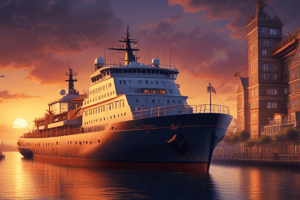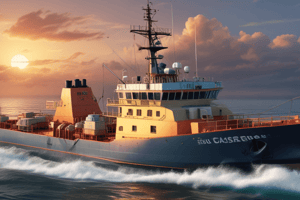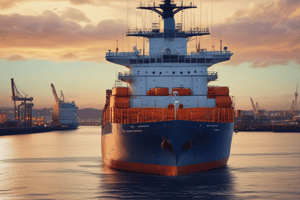Podcast
Questions and Answers
What is the primary purpose of hotel operational procedures?
What is the primary purpose of hotel operational procedures?
- To minimize costs by reducing service quality.
- To make tasks more difficult for hotel staff.
- To ensure guests receive a consistent and satisfactory experience. (correct)
- To confuse guests upon arrival.
Which task is typically included in guest check-in procedures?
Which task is typically included in guest check-in procedures?
- Ordering food supplies.
- Performing room maintenance.
- Verifying reservations and assigning rooms. (correct)
- Conducting employee performance reviews.
What does the term HVAC stand for?
What does the term HVAC stand for?
- High-Volume Automated Cleaning
- Heating, Ventilation, and Air Conditioning (correct)
- Hotel Ventilation and Central Air
- Housekeeping Visual Audit Checklist
Which of these is a key aspect of food safety and hygiene standards?
Which of these is a key aspect of food safety and hygiene standards?
What is the purpose of an inclining experiment during ship construction?
What is the purpose of an inclining experiment during ship construction?
What is the primary goal of waste management and recycling programs in hotels?
What is the primary goal of waste management and recycling programs in hotels?
Which of these is a common application of CAD software in ship construction?
Which of these is a common application of CAD software in ship construction?
What does the hotel KPI 'occupancy rate' measure?
What does the hotel KPI 'occupancy rate' measure?
Why is safety training important in ship construction?
Why is safety training important in ship construction?
Which of the following is a typical responsibility of hotel housekeeping operations?
Which of the following is a typical responsibility of hotel housekeeping operations?
What is the purpose of lockout-tagout procedures?
What is the purpose of lockout-tagout procedures?
What does a POS system do in food and beverage operations?
What does a POS system do in food and beverage operations?
What is the goal of energy conservation measures in hotels?
What is the goal of energy conservation measures in hotels?
Adherence to which principles guides the design of a ship's hull?
Adherence to which principles guides the design of a ship's hull?
What does PPE stand for regarding safety procedures?
What does PPE stand for regarding safety procedures?
What is verified at a hotel check-out?
What is verified at a hotel check-out?
Which of these is a benefit of cross-training staff?
Which of these is a benefit of cross-training staff?
What do quality control procedures address?
What do quality control procedures address?
What does 'RevPAR' measure in a hotel?
What does 'RevPAR' measure in a hotel?
What is the main point of welding inspection and quality control?
What is the main point of welding inspection and quality control?
Flashcards
Guest check-in procedures
Guest check-in procedures
Verifying reservations, confirming guest identity, assigning rooms, issuing keys, processing payments, and explaining hotel services.
Guest check-out procedures
Guest check-out procedures
Verifying charges, processing payments, issuing receipts, handling luggage, and gathering feedback.
Handling guest inquiries and complaints
Handling guest inquiries and complaints
Protocol for addressing concerns promptly and effectively, with escalation for complex issues.
Room cleaning procedures
Room cleaning procedures
Signup and view all the flashcards
Hotel laundry services
Hotel laundry services
Signup and view all the flashcards
Maintaining public areas
Maintaining public areas
Signup and view all the flashcards
Inventory management
Inventory management
Signup and view all the flashcards
Order taking and service
Order taking and service
Signup and view all the flashcards
Food safety and hygiene
Food safety and hygiene
Signup and view all the flashcards
Engineering systems design (ships)
Engineering systems design (ships)
Signup and view all the flashcards
Regulatory compliance (ships)
Regulatory compliance (ships)
Signup and view all the flashcards
Project management (ship)
Project management (ship)
Signup and view all the flashcards
Steel cutting and welding
Steel cutting and welding
Signup and view all the flashcards
Block assembly (ships)
Block assembly (ships)
Signup and view all the flashcards
Welding inspection (ships)
Welding inspection (ships)
Signup and view all the flashcards
Machinery installation (ships)
Machinery installation (ships)
Signup and view all the flashcards
Electrical wiring (ships)
Electrical wiring (ships)
Signup and view all the flashcards
Piping systems installation
Piping systems installation
Signup and view all the flashcards
Interior fitting (ships)
Interior fitting (ships)
Signup and view all the flashcards
Safety training (ships)
Safety training (ships)
Signup and view all the flashcards
Study Notes
- Operational procedures in basic hotel services and ship construction encompass a range of standardized processes and protocols designed to ensure efficiency, safety, and quality in their respective industries.
- Both sectors rely heavily on meticulous planning, execution, and monitoring to deliver consistent service and maintain operational integrity.
Hotel Services: Operational Procedures
- Hotel operational procedures are the backbone of service delivery, ensuring guests receive a consistent and satisfactory experience from arrival to departure.
Front Office Operations
- Guest check-in procedures involve verifying reservations, confirming guest identity, assigning rooms, and issuing room keys. Payment processing and explaining hotel services are also crucial.
- Check-out procedures include verifying charges, processing payments, issuing receipts, and handling luggage assistance alongside gathering feedback.
- Handling guest inquiries and complaints requires a protocol for addressing concerns promptly and effectively, often involving escalation procedures for complex issues.
- Managing reservations efficiently, including online bookings, phone reservations, and group bookings, is crucial for optimizing occupancy rates.
Housekeeping Operations
- Room cleaning procedures specify the steps for cleaning and sanitizing guest rooms, including changing linens, scrubbing bathrooms, and vacuuming.
- Laundry services involve collecting, washing, drying, and ironing linens and guest clothing, with strict procedures for handling delicate items and stains.
- Maintaining cleanliness in public areas, such as lobbies, hallways, and restrooms, requires a schedule for regular cleaning and maintenance.
- Inventory management of cleaning supplies and guest amenities ensures adequate stock levels while minimizing waste.
Food and Beverage Operations
- Order taking and service protocols in restaurants and bars outline how staff should interact with guests, take orders, and serve food and beverages according to set standards.
- Food safety and hygiene standards are critical, with procedures for handling, preparing, and storing food to prevent contamination and comply with health regulations.
- Beverage service standards cover the proper pouring, mixing, and serving of alcoholic and non-alcoholic drinks, including responsible alcohol service practices.
- Menu planning and pricing involve creating attractive and profitable menus that cater to guest preferences and meet budgetary requirements.
Maintenance and Engineering
- Regular maintenance of hotel facilities and equipment, including HVAC systems, plumbing, and electrical systems, prevents breakdowns and ensures guest comfort.
- Emergency response protocols for fire, medical emergencies, and security threats ensure the safety of guests and staff.
- Energy conservation measures, such as using energy-efficient lighting and appliances, reduce operating costs and minimize environmental impact.
- Waste management and recycling programs promote sustainability and reduce the hotel's environmental footprint.
Ship Construction: Operational Procedures
- Ship construction involves complex processes, from initial design to final outfitting, requiring strict adherence to safety regulations, quality standards, and environmental protection measures.
Design and Planning
- Naval architecture principles guide the design of the ship's hull, ensuring stability, buoyancy, and hydrodynamic efficiency.
- Engineering systems design includes the planning of propulsion, electrical, HVAC, plumbing, and communication systems.
- Regulatory compliance with international maritime regulations, such as SOLAS and MARPOL, is essential to ensure the ship meets safety and environmental standards.
- Project management involves scheduling, budgeting, and coordinating the various stages of construction to meet deadlines and control costs.
Hull Construction
- Steel cutting and welding procedures require skilled workers and automated equipment to fabricate hull sections accurately and efficiently.
- Block assembly involves joining prefabricated hull sections into larger blocks, which are then assembled in the dry dock.
- Welding inspection and quality control ensure that welds meet strength and integrity requirements, using non-destructive testing methods.
- Hull painting and coating procedures protect the steel from corrosion and fouling, extending the ship's lifespan.
Outfitting and Equipment Installation
- Machinery installation includes the placement and alignment of engines, generators, pumps, and other mechanical equipment.
- Electrical wiring and systems installation involves running cables, connecting switchboards, and testing electrical circuits.
- Piping systems installation includes the installation of pipes for fuel, water, steam, and other fluids, with pressure testing to ensure leak-free operation.
- Accommodation and interior fitting involves installing cabins, galleys, restrooms, and other interior spaces to meet passenger and crew needs.
Testing and Trials
- Dock trials involve testing the ship's systems while it is still in the dry dock, including the engines, generators, and steering gear.
- Sea trials involve testing the ship's performance at sea, including speed, maneuverability, and fuel consumption.
- Inclining experiment determines the ship's stability characteristics by measuring its response to a known weight shift.
- Regulatory inspections and certifications are conducted by classification societies and government agencies to ensure compliance with safety and environmental standards.
Safety and Quality Control
- Both hotel operations and ship construction prioritize safety and quality control to protect guests, staff, and the environment.
Safety Procedures
- Risk assessments identify potential hazards and implement control measures to prevent accidents and injuries.
- Personal protective equipment (PPE) is required for workers in hazardous areas, such as construction sites and kitchens.
- Emergency drills and training prepare staff to respond effectively to fire, medical emergencies, and other incidents.
- Lockout-tagout procedures prevent accidental start-up of machinery during maintenance and repair work.
Quality Control Procedures
- Inspections and audits verify that work is performed according to standards and specifications.
- Non-conformance reporting and corrective action procedures address any deviations from quality standards.
- Material testing ensures that materials used meet strength, durability, and safety requirements.
- Documentation and record-keeping provide a complete history of the construction or service process, facilitating traceability and accountability.
Environmental Protection
- Waste management and recycling programs minimize waste and promote resource conservation.
- Emission control measures reduce air and water pollution from ships and hotels.
- Energy efficiency initiatives reduce energy consumption and greenhouse gas emissions.
- Compliance with environmental regulations, such as MARPOL and local ordinances, is essential for responsible operation.
Technology Integration
- Technology plays an increasingly important role in both hotel operations and ship construction, improving efficiency, safety, and guest satisfaction.
Hotel Technology
- Property management systems (PMS) automate many front office functions, such as reservations, check-in/check-out, and billing.
- Point-of-sale (POS) systems streamline order taking and payment processing in restaurants and bars.
- Guest room automation systems allow guests to control lighting, temperature, and entertainment systems from their smartphones or tablets.
- Energy management systems optimize energy consumption by monitoring and controlling HVAC, lighting, and other energy-intensive systems.
Ship Construction Technology
- Computer-aided design (CAD) software is used to create detailed ship designs and engineering drawings.
- Computer-aided manufacturing (CAM) software automates the fabrication of hull sections and other components.
- 3D scanning and laser measurement technology ensure accurate alignment and fit-up of hull blocks.
- Remote monitoring and diagnostics systems track the performance of shipboard equipment and systems, enabling predictive maintenance.
Key Performance Indicators (KPIs)
- Both industries use KPIs to measure performance and identify areas for improvement.
Hotel KPIs
- Occupancy rate measures the percentage of available rooms that are occupied.
- Average daily rate (ADR) measures the average revenue earned per occupied room.
- Revenue per available room (RevPAR) measures the overall revenue performance of the hotel.
- Guest satisfaction scores measure the level of satisfaction guests have with their stay.
Ship Construction KPIs
- Project completion time measures the time taken to complete a ship construction project.
- Cost overruns measure the difference between the budgeted cost and the actual cost of the project.
- Defect rate measures the number of defects found during inspections and trials.
- Safety incident rate measures the number of accidents and injuries that occur during construction.
Training and Development
- Continuous training and development are essential to ensure that staff in both industries have the skills and knowledge necessary to perform their jobs effectively.
Hotel Training
- Customer service training teaches staff how to interact with guests in a friendly and professional manner.
- Technical training provides staff with the skills necessary to operate and maintain hotel equipment and systems.
- Leadership training develops the skills necessary for managers to lead and motivate their teams.
- Cross-training allows staff to learn multiple roles, increasing flexibility and efficiency.
Ship Construction Training
- Welding certification ensures that welders have the skills necessary to produce high-quality welds.
- Safety training teaches workers how to identify and avoid hazards on the construction site.
- Project management training develops the skills necessary for managers to plan, execute, and control ship construction projects.
- Continuing education keeps workers up-to-date on new technologies and best practices.
Studying That Suits You
Use AI to generate personalized quizzes and flashcards to suit your learning preferences.




